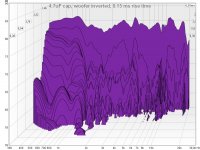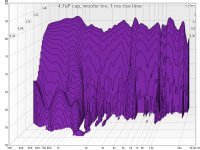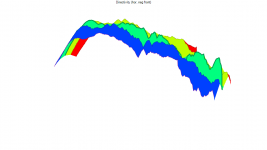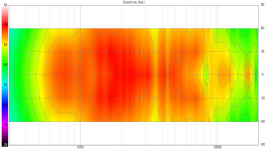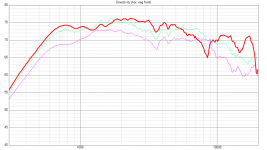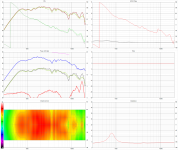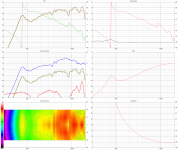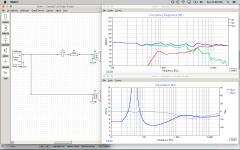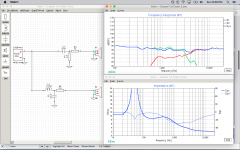There is a distortion measurement for the tweeter at 100 dB, but without XO.Onni's distortion measurement is not at high enough level to show any distortion. 95db at 1m.
Combined response with 4.8 uf cap is surprisingly good but off-axis in intended box is necessary too. I see good potential!
Do you want me to remake it with the 4.7 uF cap?
And one at 90 dB with both tweeter and woofer:
Any other measurements that are of interest?
/Anton
Onni's distortion measurement is not at high enough level to show any distortion. 95db at 1m.
Combined response with 4.8 uf cap is surprisingly good but off-axis in intended box is necessary too. I see good potential!
Agreed.
No need to be too much worried about the measurements. Compared to that Lowther measurements recently shown you got it ruler flat! Just listen to it with a cap and also NOthing inverted - I would suggest. You may try a few caps and add a single series resistor to woofer or tweeter as needed. Then might try a small inductor on the woofer. Who knows? Simple is the best when timing and coherence is aimed. And this is what coax for...
Nothing inverted does not really work with just a cap afaik.Agreed.
No need to be too much worried about the measurements. Compared to that Lowther measurements recently shown you got it ruler flat! Just listen to it with a cap and also NOthing inverted - I would suggest. You may try a few caps and add a single series resistor to woofer or tweeter as needed. Then might try a small inductor on the woofer. Who knows? Simple is the best when timing and coherence is aimed. And this is what coax for...
This is impulse and step response for the 4.7uF XO:
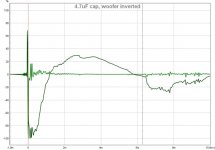
The step is wrong direction due to wrong polarity, I guess that's what you would want to fix.
/Anton
Distortion and CSD figures are good, their bare tweeter is indeed of second-to-none performance and yes there is some potential in these drivers becouse the fact that they are coaxial... I'm concerning about diffraction issues and poorly implemented waveguide. There is always something characteristic about far-east products: Everything usually looks good except one particular random and irritating thing which can sometimes stop you from engineering something serious out of it. We are talking about expensive drivers, not 50 $ ones.
This actually does look very decent. I want to see what the 8” has in stock, as the smaller one isn’t sensitive enough for my uses. I plan to mate it to a sb wo24p in a closed box.
I'd rather wait for Satori coax in your case. You should be able to get really solid performance out of this combo.
I'd rather wait for Satori coax in your case. You should be able to get really solid performance out of this combo.
The tweeter curve looks really strange on the SB. With that said I’d really like it to succeed.
I feel that they made a mistake when using a concave tweeter in a coaxial. They should have looked closer at the drive unit in Kef LS50 which seems a lot more thought through and also achieves a lot better polars (espesially on axis).
View attachment 715296
/Anton
TAD uses a cone tweeter and got great polars. KEF's phase plug does a better job of getting rid of the axial cancellation notch.
The tweeter curve looks really strange on the SB. With that said I’d really like it to succeed.
No offence against TB coax, I was waiting for it for nearly half a year and I feel kinda disappointed... My arm and leg for Satori coax which performance will be better than this. Will probably be better than regular Satori woofers (becouse of lack of visible edge resonance due to new multi-roll suspension) and tweeters as well (becouse of waveguide of course). Tweeter response visible inside of SB datasheet is well behaved and smooth, especially after minor DSP reworking, in opposition to TB coax with worse tweeter directivity control as Onni's meaurement clearly showed. SB datasheets usually show the truth, in opposition to TB 'graphs'.
Last edited:
I only bought one...
There is no built-in XO. I tested with a single cap as it was suggested in the thread. It works, but it's not very "flat". I tested two values.
Tweeter with cap:
View attachment 715279
Together with woofer (inverted):
View attachment 715278
Distortion with only a 10uF cap:
View attachment 715280
Not sure if the single cap is enough protection, but it seems so given the low distortion. But someone more capable will probably design both very simplistic and quite complicated crossovers that you can use.
/Anton
Thanks can you get access to the tweeter's and woofer's terminals separately if not then how do you mount the tweeter.
Here are some measurements I've done...
Great thanks sharing nice work.
Tracing tweeter the three curves from post 93 and get impedance curve from TB datasheet gives below temporary model of polar into VituixCAD, in last attachment a single 4,7uF capacitor is modelled.
For Power & DI graphs blue trace is Power response and red trace is Directivity index and set to model 2pi.
Attachments
Last edited:
I just read the Satori coax thread Good discussion.
Obviously there is not enogh room for the tweeter in Satori M16 (voice coil diameter)
Coaxials are a bunch of compromises always! I think that best balance comes with 5" midrange. Because cone doesn't need much Xmax, you can make it light and rigid with neat surround. This gives low and high cone resonaces out of passbad. Small Xmax also makes tweeter's fitting easier, giving again less interferencies way up in passband. So - KEF 5" and TB 5" are on right tracks. Then there is fine tuning and attention to details - that's whre KEF shines!
It is very important to look at off-axis response of the tweeter! In a waveguide with less than optimal fitting (like always in coaxials except Genelec), on-axis has interferences that get compensated +/-15¤ , then actual response for the listener is flat.
I am a big fan of SEAS coaxials, My HT fronts use T18REX/ACG and I have a pair of MR18 for a new project. Gradient Labs is famous for using SEAS coaxials and we have many other speakers, kits and published diy projects for them in Finland.
Obviously there is not enogh room for the tweeter in Satori M16 (voice coil diameter)
Coaxials are a bunch of compromises always! I think that best balance comes with 5" midrange. Because cone doesn't need much Xmax, you can make it light and rigid with neat surround. This gives low and high cone resonaces out of passbad. Small Xmax also makes tweeter's fitting easier, giving again less interferencies way up in passband. So - KEF 5" and TB 5" are on right tracks. Then there is fine tuning and attention to details - that's whre KEF shines!
It is very important to look at off-axis response of the tweeter! In a waveguide with less than optimal fitting (like always in coaxials except Genelec), on-axis has interferences that get compensated +/-15¤ , then actual response for the listener is flat.
I am a big fan of SEAS coaxials, My HT fronts use T18REX/ACG and I have a pair of MR18 for a new project. Gradient Labs is famous for using SEAS coaxials and we have many other speakers, kits and published diy projects for them in Finland.
Last edited:
Just saw these on PE. Very cool driver.
Omni, have you tried listening to it with just the 4.7uF in there? When I sim that XO, it looks very toppy, quite unlike your measurements (below for comparison). I had to pad it down with 6.8R to get something close to your results. Weird. I am entirely new to XSim, so hopefully I will learn something here.
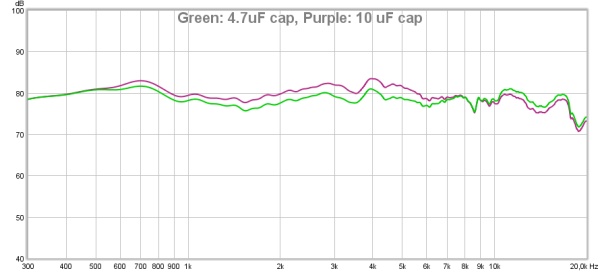
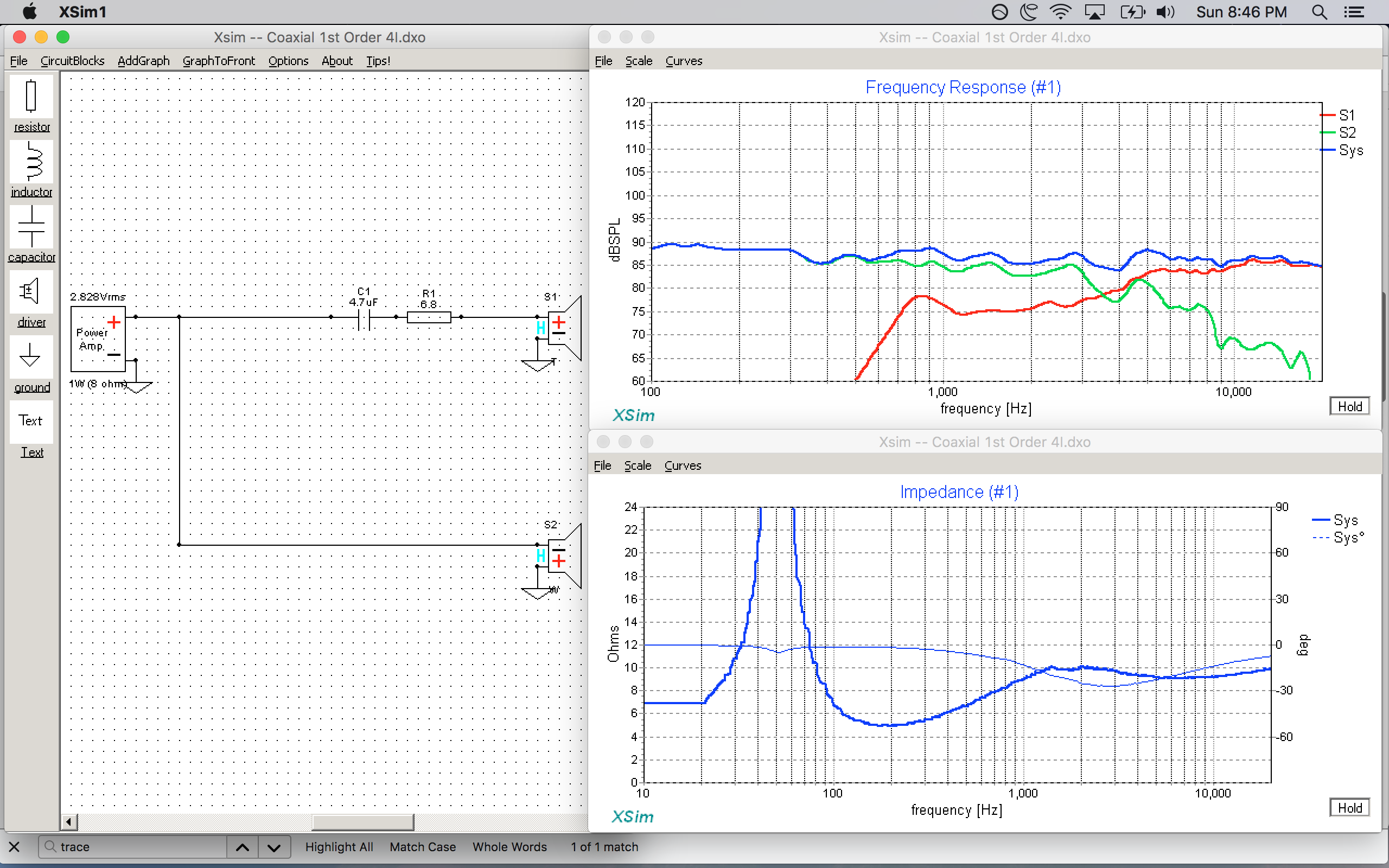
I also tried to see if I could do first order XO without inverting a driver. It felt rather unwieldy with seemingly more cancellation(?) going on, and I guess I bombed this attempt. Big loss of efficiency and impedance takes a nosedive...lol. As I said, I'm a newbie
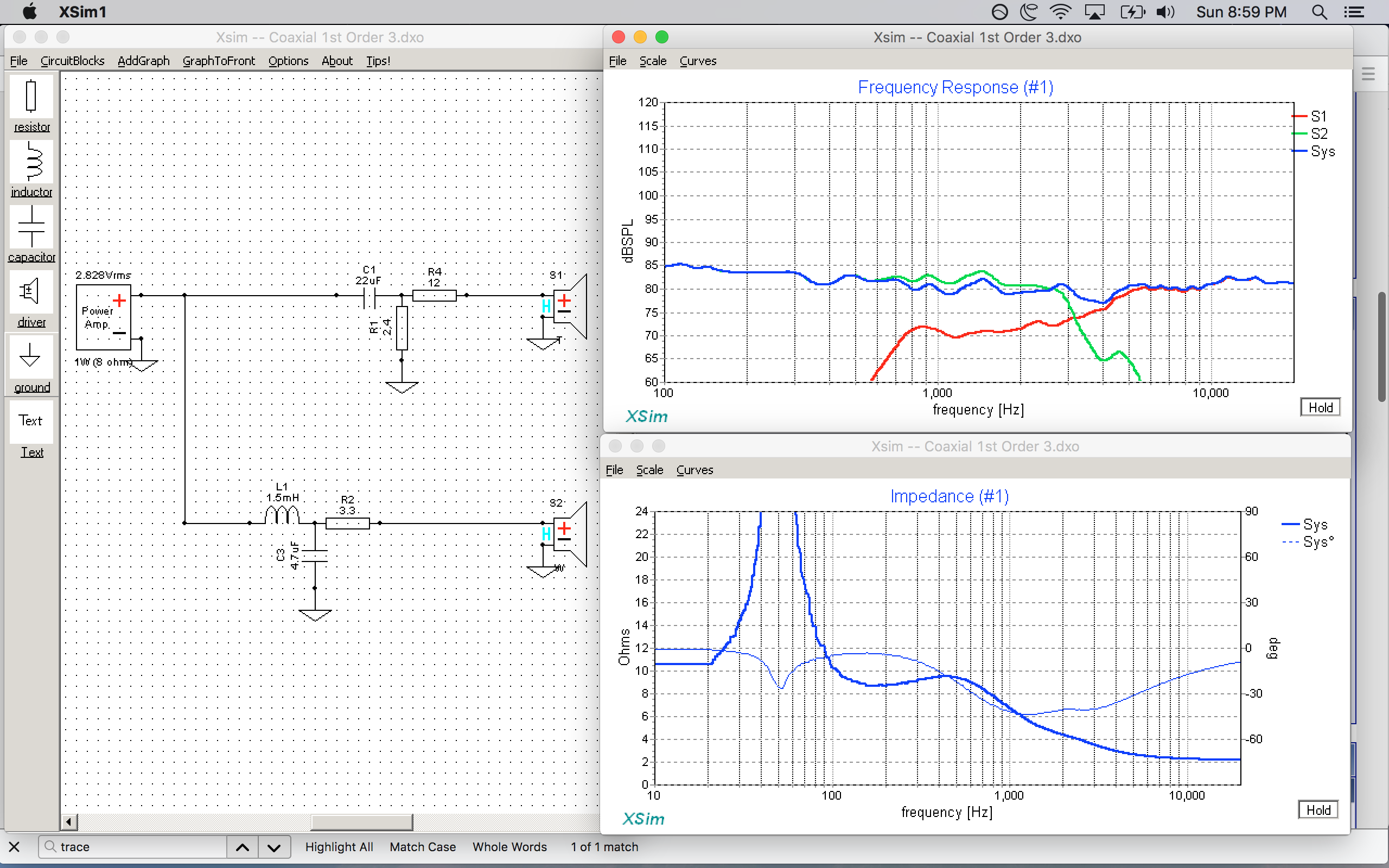
Is it possible, or worthwhile, for that matter, to have these drivers in phase for more precise time alignment? The acoustic centers are already aligned for us, right? I really like the focus of full range drivers, but I hate being glued to the listening position for a satisfying treble experience. Wondering if these are for me.
Omni, have you tried listening to it with just the 4.7uF in there? When I sim that XO, it looks very toppy, quite unlike your measurements (below for comparison). I had to pad it down with 6.8R to get something close to your results. Weird. I am entirely new to XSim, so hopefully I will learn something here.
I also tried to see if I could do first order XO without inverting a driver. It felt rather unwieldy with seemingly more cancellation(?) going on, and I guess I bombed this attempt. Big loss of efficiency and impedance takes a nosedive...lol. As I said, I'm a newbie
Is it possible, or worthwhile, for that matter, to have these drivers in phase for more precise time alignment? The acoustic centers are already aligned for us, right? I really like the focus of full range drivers, but I hate being glued to the listening position for a satisfying treble experience. Wondering if these are for me.
Attachments
stellarelephant is right about listening experience.
- If you run the woofer full range with no tweeter, would you get too much crap or just a smooth attenuation in the upper midrange? Say with some solo violin or guitar music... That bamboo fiber paper cone looks very similar to those used in some legendary full-range TB speakers.
- The woofer may allow one to use the tweeter as a "super tweeter" with only a *small* cap and perhaps a only a series resistor. Don't worry too much about the polar response as the 1st order filter will still cover a quite wide range, melting very smoothly with the woofer. In this case it would worth to try both inverted and non-inverted tweeter. I bet the non-inverted will win - no matter what all those measurements and sims say.
Also note that some folks tried running (for example) T18REX/XFC this way and liked it a lot.
- If you run the woofer full range with no tweeter, would you get too much crap or just a smooth attenuation in the upper midrange? Say with some solo violin or guitar music... That bamboo fiber paper cone looks very similar to those used in some legendary full-range TB speakers.
- The woofer may allow one to use the tweeter as a "super tweeter" with only a *small* cap and perhaps a only a series resistor. Don't worry too much about the polar response as the 1st order filter will still cover a quite wide range, melting very smoothly with the woofer. In this case it would worth to try both inverted and non-inverted tweeter. I bet the non-inverted will win - no matter what all those measurements and sims say.
Also note that some folks tried running (for example) T18REX/XFC this way and liked it a lot.
stellarelephant is right about listening experience.
- If you run the woofer full range with no tweeter, would you get too much crap or just a smooth attenuation in the upper midrange? Say with some solo violin or guitar music... That bamboo fiber paper cone looks very similar to those used in some legendary full-range TB speakers.
- The woofer may allow one to use the tweeter as a "super tweeter" with only a *small* cap and perhaps a only a series resistor. Don't worry too much about the polar response as the 1st order filter will still cover a quite wide range, melting very smoothly with the woofer. In this case it would worth to try both inverted and non-inverted tweeter. I bet the non-inverted will win - no matter what all those measurements and sims say.
Also note that some folks tried running (for example) T18REX/XFC this way and liked it a lot.
Hi Murat,
Running the woofer full-range is exactly what Omni was doing when he took the VERY nice-looking measurements I re-posted above (green and purple lines). Nothing on the woofer and only a cap on the tweeter! How does it sound, though?
stellarelephant, in case you missed it - Tang Band have published a suggested cabinet and crossover which might be of interest to you http://tb-speaker.com/uploads/files/98641fa4c3fd3aeee3bb12225b475ed4.pdf
- Home
- Loudspeakers
- Multi-Way
- TB new line of Coax FR drivers
